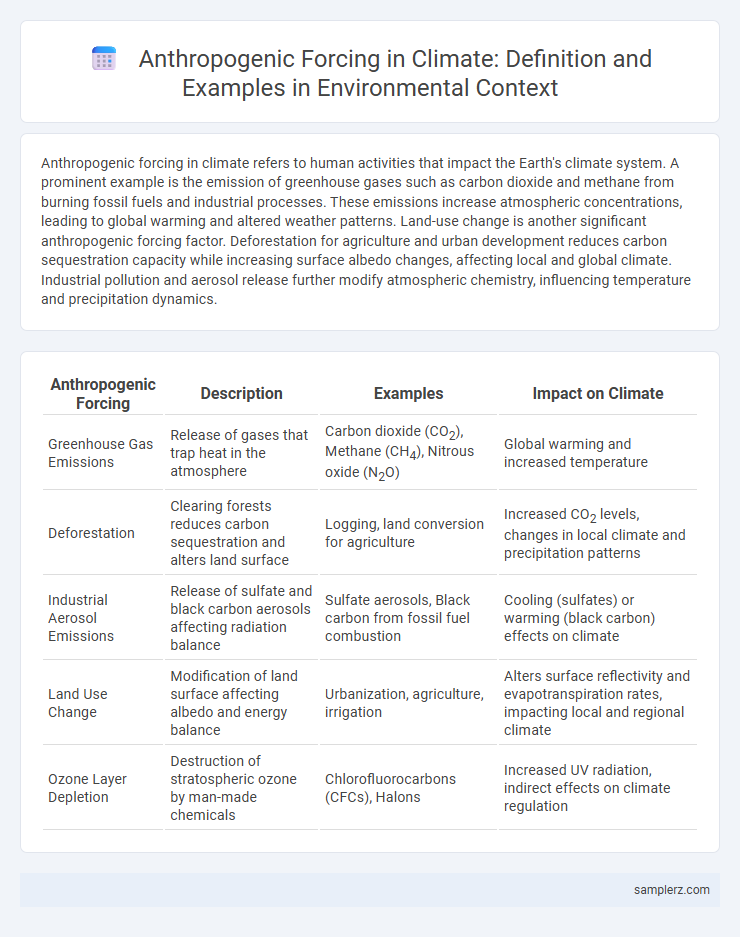Anthropogenic forcing in climate refers to human activities that impact the Earth's climate system. A prominent example is the emission of greenhouse gases such as carbon dioxide and methane from burning fossil fuels and industrial processes. These emissions increase atmospheric concentrations, leading to global warming and altered weather patterns. Land-use change is another significant anthropogenic forcing factor. Deforestation for agriculture and urban development reduces carbon sequestration capacity while increasing surface albedo changes, affecting local and global climate. Industrial pollution and aerosol release further modify atmospheric chemistry, influencing temperature and precipitation dynamics.
Table of Comparison
| Anthropogenic Forcing | Description | Examples | Impact on Climate |
|---|---|---|---|
| Greenhouse Gas Emissions | Release of gases that trap heat in the atmosphere | Carbon dioxide (CO2), Methane (CH4), Nitrous oxide (N2O) | Global warming and increased temperature |
| Deforestation | Clearing forests reduces carbon sequestration and alters land surface | Logging, land conversion for agriculture | Increased CO2 levels, changes in local climate and precipitation patterns |
| Industrial Aerosol Emissions | Release of sulfate and black carbon aerosols affecting radiation balance | Sulfate aerosols, Black carbon from fossil fuel combustion | Cooling (sulfates) or warming (black carbon) effects on climate |
| Land Use Change | Modification of land surface affecting albedo and energy balance | Urbanization, agriculture, irrigation | Alters surface reflectivity and evapotranspiration rates, impacting local and regional climate |
| Ozone Layer Depletion | Destruction of stratospheric ozone by man-made chemicals | Chlorofluorocarbons (CFCs), Halons | Increased UV radiation, indirect effects on climate regulation |
Overview of Anthropogenic Forcing in Climate Change
Anthropogenic forcing in climate change primarily involves the increase of greenhouse gases such as carbon dioxide (CO2), methane (CH4), and nitrous oxide (N2O) emitted from burning fossil fuels, deforestation, and industrial processes. These emissions enhance the natural greenhouse effect, leading to global temperature rise and altered weather patterns worldwide. Land-use changes and aerosol emissions also modify Earth's radiation balance, contributing to climate variability and long-term shifts.
Fossil Fuel Combustion and Greenhouse Gas Emissions
Fossil fuel combustion is a primary example of anthropogenic forcing in climate change, releasing large quantities of carbon dioxide (CO2), methane (CH4), and nitrous oxide (N2O) into the atmosphere. These greenhouse gas emissions trap infrared radiation, enhancing the natural greenhouse effect and driving global temperature increases. Industrial activities, power generation, and transportation are major sources contributing to elevated atmospheric greenhouse gas concentrations.
Industrial Agriculture’s Impact on Climate
Industrial agriculture significantly contributes to anthropogenic forcing through the release of greenhouse gases such as methane from livestock, nitrous oxide from synthetic fertilizers, and carbon dioxide from deforestation for cropland expansion. Large-scale monoculture practices degrade soil carbon stocks and disrupt natural ecosystems, amplifying climate change effects. Intensive irrigation systems also increase energy consumption, further elevating agriculture's carbon footprint within the global climate system.
Deforestation and Land Use Change
Deforestation and land use change are significant examples of anthropogenic forcing that accelerate climate change by altering the Earth's carbon cycle and reducing carbon sequestration capacity. Clearing forests for agriculture or urban development releases large amounts of stored carbon dioxide into the atmosphere, exacerbating greenhouse gas concentrations. These human activities disrupt local ecosystems, increase surface albedo, and contribute to global warming through changes in land surface properties.
Urbanization and the Heat Island Effect
Urbanization significantly contributes to anthropogenic forcing by altering land surfaces and increasing energy consumption, resulting in the urban heat island effect. This phenomenon causes localized temperature rises due to concrete, asphalt, and reduced vegetation, intensifying heat retention in cities. Elevated urban temperatures exacerbate air pollution, increase energy demand for cooling, and amplify climate change impacts.
Aerosol Emissions from Human Activities
Aerosol emissions from human activities, such as industrial processes, vehicle exhaust, and biomass burning, significantly contribute to anthropogenic forcing in climate change by altering the Earth's radiative balance. These aerosols can either cool the atmosphere by reflecting sunlight or warm it by absorbing heat, with substances like black carbon having a strong warming effect. Understanding the spatial distribution and chemical composition of anthropogenic aerosols is crucial for accurate climate modeling and developing effective mitigation strategies.
Transportation Sector as a Climate Driver
The transportation sector is a significant source of anthropogenic forcing, primarily through the emission of carbon dioxide (CO2) and methane (CH4) from vehicles powered by fossil fuels. Internal combustion engines in cars, trucks, ships, and airplanes contribute approximately 14% of global greenhouse gas emissions, accelerating climate change. Innovations in electric vehicles, public transit, and alternative fuels aim to reduce the sector's carbon footprint and mitigate its impact on global warming.
Industrial Processes and Pollutant Release
Industrial processes contribute significantly to anthropogenic forcing in climate change by releasing large quantities of greenhouse gases such as carbon dioxide (CO2) and methane (CH4) through the combustion of fossil fuels and chemical reactions. Pollutant release from manufacturing activities includes emissions of sulfur hexafluoride (SF6), a potent greenhouse gas used in electrical insulation, which has a global warming potential thousands of times greater than CO2. These industrial emissions exacerbate atmospheric greenhouse gas concentrations, driving global temperature rise and disrupting climate patterns.
Waste Management and Methane Production
Anthropogenic forcing in climate change is significantly influenced by waste management practices, particularly through methane production from landfills. Methane, a potent greenhouse gas, is released during the anaerobic decomposition of organic waste, contributing substantially to global warming potential. Effective management strategies such as methane capture and composting can mitigate these emissions and reduce the environmental impact.
Case Studies of Human-Induced Climate Events
Deforestation in the Amazon rainforest exemplifies anthropogenic forcing, where large-scale tree removal accelerates carbon dioxide emissions and disrupts global climate patterns. Urban heat islands, particularly in metropolitan areas like Tokyo and New York City, increase localized temperatures due to extensive concrete surfaces and vehicular emissions. Industrial activities in regions such as China's Hebei province contribute significantly to greenhouse gas concentrations, intensifying regional and global climate changes.

example of anthropogenic forcing in climate Infographic
 samplerz.com
samplerz.com